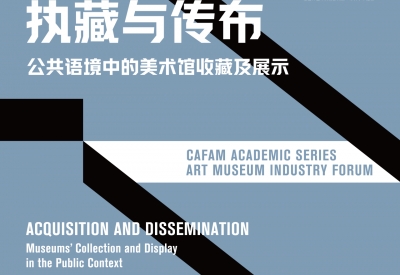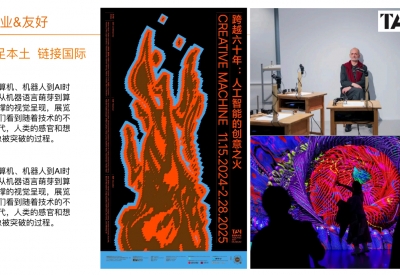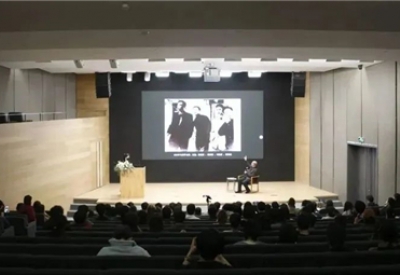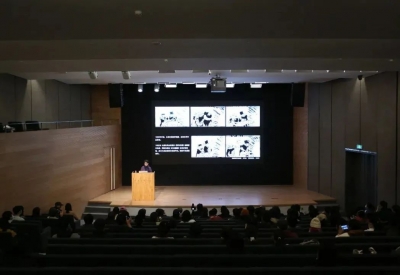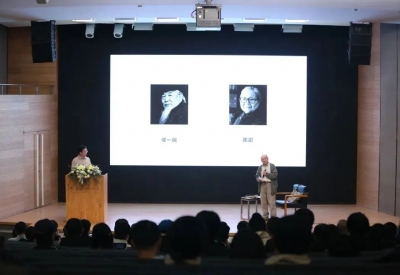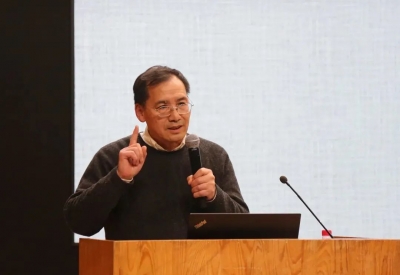2025-08-16
356 read
Wuhan Art Museum Chen Yongjin「In today's world where digitalization and globalization are intertwined, art museums are facing multiple challenges: the fragmentation of audience needs, the complexity of social issues, and the diversity of cultural identities. This has made the mission of art museums go far beyond the traditional preservation and display of artworks, turning them into platforms for dialogue on social issues and hubs for knowledge production.Artistic innovation in art museums drives social innovation and strengthens cultural confidence and self-improvement.To push China's art museum cause to a new level and contribute Chinese strength to the diversity and innovation of global culture and art, we need to summarize practical experiences in running art museums.Over the years, Wuhan Art Museum has reconstructed the public value of art museums through two core strategies: diversified curation and knowledge renewal. It has transformed from "single display" to "multi-dimensional interaction" and from "preservation of culture" to "empowerment of society". It has always maintained a forward-looking vision and innovative posture, and solidly fulfilled the historical mission of cultural inheritance and innovation.」1.Originality: Diversified Curation and Rich ExperiencesOriginality: Diversified Curation and Rich ExperiencesRooted in the cultural context of central China, Wuhan Art Museum has, through 11 years of development, gradually formed a unique curatorial thread: relying on the city, guided by themes, focusing on the contemporary era, and expanding to an international scope; while paying attention to classics, ink painting, contemporary art, and local works.Wuhan Art Museum demonstrates cultural confidence in its thematic expression. These interwoven and mutually inspiring threads constitute the systematic curatorial framework of Wuhan Art Museum.Curating based on traditional cultural context1、Curating based on traditional cultural contextTradition is the foundation of art museums' cultural practices. Since the opening of the new Wuhan Art Museum in 2008, the museum has been rooted in the context of traditional Chinese painting and implemented the guiding ideology of creative transformation and innovative development. It has created a series of exhibitions featuring masters, successively launching exhibitions of works by 20th-century Chinese painting masters such as Wu Changshuo, Qi Baishi, and Fu Baoshi, presenting classic works in the history of modern and contemporary Chinese art.In 2011, out of considerations on cultural missions and ink-wash language, Wuhan Art Museum initiated the academic project "Ink Writings: Series of Research Exhibitions on Contemporary Ink Art". This project showcases the rich forms of ink-wash art in the contemporary context. Up to now, 8 sessions have been successfully held, making it an exhibition brand that continuously focuses on the development of Chinese contemporary ink art.Curating rooted in local ground2、Curating rooted in local groundThe curation of Wuhan Art Museum has always been rooted in local culture and based on the spiritual context of the city. Adhering to the mission of "Art beautifies a city, and art enlightens beautiful souls", Wuhan Art Museum has curated a series of strategic exhibitions that uniquely embody the spirit of Wuhan. It explores Wuhan's distinctive identity as a thoroughfare connecting nine provinces and its rich cultural context, organizes exhibitions of its collection, persists in activating its collections to serve society, promotes domestic and international tours, and enhances mutual learning about urban humanities and art through sister cities and sister museums.Curation independently planned with concern for youth3、Curation independently planned with concern for youthYoung artists are the future and hope of the art ecosystem. Based on this consideration, Wuhan Art Museum has focused on creating an independently curated brand, "Starlight Project: Research Exhibition of Young Artists". Currently, the ninth edition is being planned to present the latest experimental achievements of artists in multi-category contemporary art creation and conduct discussions. In recent years, Wuhan Art Museum has collected hundreds of works by participating artists.Supporting young artists not only promotes the future development of art but also injects new vitality into the art museum, building a system integrating creation, research, collection, and promotion.Embracing the Future: Diversified Curation4、Embracing the Future: Diversified CurationIn the current context where digital civilization and urban renewal are intertwined, biennales possess irreplaceable cultural attributes. In 2022, the Qintai Branch of Wuhan Art Museum officially opened to the public, transforming the abstract ancient beautiful story of "seeking a soulmate through the melody of high mountains and flowing water" into a tangible art space.Unveiled alongside this art museum was "Art as a Thoroughfare – 2022 Wuhan Biennale". It is an international biennale that integrates an international perspective, Chinese sentiments, and Wuhan characteristics, inviting artists from 24 countries to participate and receiving a total of over 600,000 visitors.The 2024 Wuhan Biennale takes "Urban Fluidity" as its theme, rooted in the Yangtze River civilization and the civilizations of world powers. On the one hand, it uses "fluidity" to imply the water culture characteristics of Wuhan, which is located in the middle and lower reaches of the Yangtze River; on the other hand, it emphasizes the diversity, innovation, and sustainability that Wuhan, as a national central city, presents in culture, science and technology, education, and other fields.2.Innovation: Knowledge Renewal and Future OutlookBuilding a multi-dimensional cooperation systemThe rapid development and extensive application of digital technologies have significantly driven social and cultural progress as well as economic transformation, while also providing brand-new means and vast space for artistic creation. Against this backdrop, Wuhan Art Museum actively promotes the resonant development of regional culture and world art, continuously updates its knowledge production mechanism, and 始终 maintains an open attitude and exploratory spirit towards new ideas, new technologies, and new possibilities.1. Building a multi-dimensional cooperation system and creating an open art communityCarrying out cross-border cooperation is an important way for contemporary art innovation. Wuhan Art Museum has continuously expanded its professional boundaries and social functions through cooperation with universities, research institutions, etc. For example, "Beyond Exhibition Language: Art and Healing" is an attempt of cooperation between Wuhan Art Museum and Wuhan Union Hospital, which not only enriches the exhibition content of the art museum but also provides more diversified interactive experiences for different groups of people. In the future, Wuhan Art Museum will continue to explore the integration of art with other disciplines and further expand the boundaries of the art museum.Creating an Open Art CommunityIn conjunction with the urban renewal plan, Wuhan Art Museum has integrated aesthetic education activities into the renovation of neighborhoods. Meanwhile, it has built Hubei Province's first community art museum, becoming a hub for aesthetic education and community development in the new era. Relying on the museum's collection resources, it has realized the sharing and co-construction of art, making art accessible to the general public.While continuously strengthening services for the grassroots and the public nature of art, Wuhan Art Museum has made full use of modern technology to enhance the sharing of online resources. Through forms such as online exhibitions and lectures, it has broken the limitations of time and space, achieving positive interaction between online and offline platforms.Digital Empowerment for Art Renewal2、Digital Empowerment for Art Renewal, Jointly Painting the Urban Cultural LandscapeThe integration of art and technology is becoming an important force to stimulate human creativity in the era of artificial intelligence. Digital art is increasingly becoming a hot topic in the field of public culture.The "2024 Wuhan Biennale" has actively expanded the definition of art, introducing artistic creations that combine AI technology and ecological concepts into the exhibition with a more open attitude. In terms of promotion, it has utilized digital technologies to build a new field of two-way communication between humanities and science, providing audiences with brand-new viewing perspectives and thinking paths."Urban Fluidity" 2024 Wuhan BiennaleIn recent years, Wuhan Art Museum has deepened the public education concept of "lighting up urban imprints with art" and built a national aesthetic education system in the new era, reaching more than 300,000 people annually. The public education project "Lighting up the Stars' Children with Art – The Decibel of Art" has gathered social public welfare forces. Through diversified methods such as subject assistance and cultural and creative promotion, it helps special groups boost their confidence in the infiltration of aesthetic education projects and innovates effective carriers for cultural education.Wuhan Art Museum has always promoted the in-depth integration of art, culture and tourism, adhered to "promoting tourism with culture and highlighting people through tourism" as a urban hotspot, improved the urban cultural quality, and continuously innovated the implementation plan of public aesthetic education.Culture and tourism jointly paint the urban landscapeThe practices of Wuhan Art Museum have demonstrated that "original creativity and innovative drive" are not only catalysts for artistic innovation, knowledge production, and social participation, but also the code for the renewal of art museums. Through the integration of locality and globality, the interweaving of technology and humanity, and the dialogue between art and the public, art museums are transforming from cultural containers into cultural engines.In the future, this engine will continue to drive the flow and regeneration of urban civilization, becoming a hub connecting history and the future, the local and the global, as well as art and life. In this way, art museums will better play a leading role in serving economic and social development and meeting the people's needs for a high-quality life.Introduction of the Speaker▏Chen YongjinChen Yongjin graduated from Hubei Institute of Fine Arts. He started working at Hubei Academy of Fine Arts in 1994, serving as the director of the Oil Painting and Watercolor Creation Research Office. In 2014, he took up a position at Wuhan Painting Academy as its president. Since 2020, he has been working at Wuhan Art Museum as the curator, holding the title of First-Class Artist (with a professional and technical rank of Level 2). He also serves as the Deputy Secretary-General of the Watercolor Art Committee of the China Artists Association, Vice-Chairman of the Hubei Artists Association, a distinguished professor at Hubei Institute of Fine Arts, and the Exhibition Director of the 2024 Wuhan Biennale. His works have been exhibited at institutions including the Shanghai Museum, National Art Museum of China, Chiba Museum of Art, Guan Shanyue Art Museum, Shanghai Art Museum, and Hubei Museum of Art.∨Chief Editor / He YishaExecutive Editor / Du YinzhuEditor / Wang YifanText Collation / Li Ze
More

